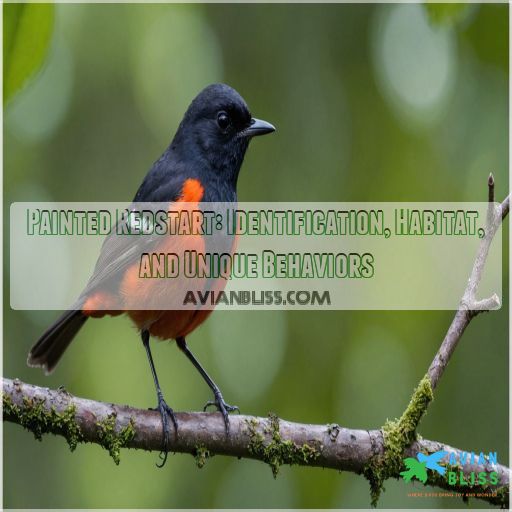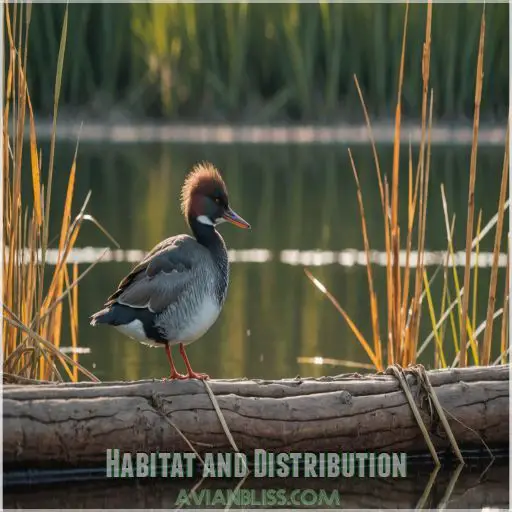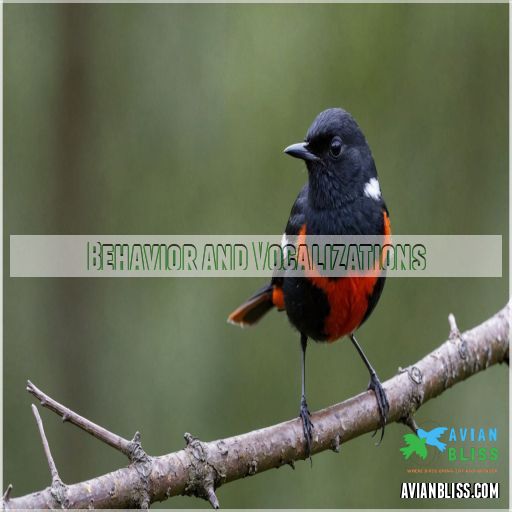This site is supported by our readers. We may earn a commission, at no cost to you, if you purchase through links.

It loves to hang out in the pine-oak forests from California to Texas. You’ll often see it flashing its wings to scare up lunch—insects beware!
Nestled among moss and bark, their ground nests are expertly hidden. These warblers are all about family time, singing sweet duets while taking care of their chicks.
Curious to know more about their thrilling survival tactics and vibrant lifestyle? Keep an eye on their amazing antics!
Table Of Contents
- Key Takeaways
- Painted Redstart Identification
- Habitat and Distribution
- Unique Characteristics
- Behavior and Vocalizations
- Breeding and Nesting
- Diet and Foraging
- Conservation Status and Threats
- Frequently Asked Questions (FAQs)
- What is the difference between American Redstart and painted Redstart?
- Is a painted redstart a warbler?
- Where are painted Redstarts found?
- How does climate change affect painted redstarts?
- What are painted redstart migration patterns like?
- Can painted redstarts be found outside the Southwest?
- Do painted redstarts interact with other bird species?
- Are painted redstarts commonly seen during winter?
- Conclusion
Key Takeaways
- When you’re out birdwatching and spot a painted redstart, you’re witnessing nature’s own fireworks. With its bold black, red, and white feathers, it’s like spotting a feathered superhero in the wild, bringing stories of pine-oak forests from California to Texas right to your binoculars.
- These birds aren’t just pretty faces; they’re dynamic performers with tricks up their sleeves, like flashing their wings to flush out insects. Watching them is like attending nature’s own rock concert, with vibrant plumage and cheery songs filling the air.
- Habitat is everything for the painted redstart. They thrive in the shady sanctuaries of oak canyons, but their ground nests deserve a special mention—a cozy, hidden sanctuary crafted like a secluded artist’s studio.
- Conservation is crucial for these colorful wonders. Climate change and habitat loss threaten their vibrant lifestyle, but with some superhero-level teamwork, we can ensure these beautiful birds continue to flit about, bringing joy and color to mountain forests and beyond.
Painted Redstart Identification
Spotting a Painted Redstart is like seeing fireworks in the forest; you’ll notice its striking black body, vivid red chest, and flashy white tail feathers.
It’s the size of a sparrow, but those bold colors make it unforgettable, even juveniles will charm you with their evolving plumage, which is a striking black body
Distinctive Color Patterns
Spotting a painted redstart is like seeing a feathered artist in action.
Their distinctive color patterns are truly eye-catching: a bright red chest provides sharp contrast against sleek black feathers, reminiscent of other black birds with red chests like the Red-breasted blackbird
.
Keep an eye out for the white wing patches; they practically wave at you.
Juvenile plumage adds a bit of color variation, and understanding these patterns enhances bird-watching joy.
The distinctive appearance of the painted redstart makes it a unique sight, similar to watching a feathered artist.
Body Size and Shape
Imagine you’re a birdwatcher exploring southwestern arid woodlands, and suddenly, a painted redstart flutters into view.
This small, energetic bird flaunts a wingspan of 9 inches and a sleek silhouette, with its bill and head perfectly balanced.
Its long tail, ideal for graceful maneuvers, illustrates nature’s clever artistry.
Isn’t it a treat to witness?
Plumage and Markings
If you’re lucky enough to spot a Painted Redstart, you’ll be captivated by its striking plumage.
This bird boasts:
- Jet-black head, back, and wings that contrast beautifully with its bright white tail feathers
- A vibrant red chest patch that stands out like a fiery beacon
- Unique wing and tail patterns that it flashes during its energetic flight displays
Perched atop a high branch, the Painted Redstart is a true showstopper.
Juvenile Characteristics
You’re charmed by the Painted Redstart’s adult plumage, but juveniles tell a different tale. Their muted plumage lacks the vibrant adult red coloration, reflecting their growth journey
. Marvel at how molt timing influences their year-long transformation!
Here’s a quick table for you:
| Feature | Description | Notes |
|---|---|---|
| Juvenile Plumage | Duller tones | Less red yet |
| Growth Rate | Steady and gradual | Fledgling phase |
| Parental Care | Attentive, nurturing | Essential support |
| Nesting | Ground nests | Well-concealed |
The young ones may seem understated now, but they’re growing!
Habitat and Distribution
You’ll find the Painted Redstart flitting about in the shady sanctuaries of oak canyons and pine-oak forests around 5,000 feet, from California to Texas.
This flashy little bird loves its wilderness retreats, and sometimes you might even catch it chilling in riparian woodlands during the colder months.
Geographic Range and Migration
With a vibrant splash of flair, the Painted Redstart showcases its impressive migration patterns.
This delightful bird journeys across a broad geographic range, making seasonal movements with ease.
Picture stunning scenes:
- Canyons echoing with its call
- Forests bustling with activity
- Wintering grounds teeming with life
- Elevation shifts marking its adventurous path
Such a traveler deserves applause!
Preferred Breeding and Wintering Grounds
Landing in scenic high elevations, the Painted Redstart prefers breeding in pine-oak-fir forests. During winter, they migrate to Central America, mingling with deciduous trees and riparian woodlands.
Their habitat preferences are similar to those of the Slate-throated Redstart, which can be found in humid forests and woodlands. This overlap in habitat highlights the importance of conservation efforts in protecting these ecosystems.
Marvel at their scenic travel guide below:
| Elevation Preferences | Habitat Overlap | Migration Patterns |
|---|---|---|
| 1,200-2,300 m | Pine-oak-fir forests | Breed in Arizona |
| 1,200-2,300 m | Riparian woodlands | Winter in Central America |
| Deciduous trees |
Despite threats to wintering grounds, conservation efforts thrive.
Association With Oak and Pine-Oak Forests
Imagine wandering into mountain forests dotted with emory oaks and Arizona white oaks. Here, the Painted Redstart truly thrives! These birds favor these areas for their rich oak-forest ecology. They also play a part in forest regeneration. Look for their nests tucked among pine needles, hidden on steep slopes.
- Rich in oak-forest ecology.
- Pine-oak dependence ensures survival.
- Nest placement uses natural slopes.
- Fire impact can threaten habitats.
- Habitat selection driven by food and shelter.
Riparian Woodland Habitats
In riparian woodland habitats, you’ll find Painted Redstarts thriving near water sources and lush canyon ecosystems.
Picture them dancing along a creek bed, skillfully moving through undergrowth’s fine grasses and oak leaves.
They love streamside foraging, their antics a delight to watch.
Human impact may pose risks, yet these birds remind us that nature’s beauty lies just downslope.
Unique Characteristics
You’re in for a real treat with the Painted Redstart.
This flashy warbler may not be closely related to the American Redstart, but its vibrant red chest and white wing patches make it a true showstopper.
And get this – some folks even call it the "Painted Whitestart" because of those eye-catching white markings.
Talk about a unique bird!
Warbler Family Classification
Why is the Painted Redstart so intriguing in the Warbler family classification?
This bird’s unique traits, linked through phylogenetic relationships, paint a picture of warbler diversity and evolutionary history like the black mohawks of various species
.
Unlike your common yellowthroat or the heftier white-throated sparrow, it thrives in global breeding populations, showcasing remarkable conservation management strategies.
Break out the field guides, fellow birders, to explore the Warbler diversity.
Unrelated to American Redstart
The Painted Redstart and the American Redstart might share a name, but they’re unrelated birds, each with unique evolutionary histories.
Let’s explore their differences:
- Painted Redstarts flaunt a bright red belly, unlike the American version.
- They’ve distinct taxonomic classifications.
- Similar species vary across regions.
- Range differences highlight climate change impacts.
- Keep your cats indoors; these birds love backyard feeders!
Common Name Variations
While the Painted Redstart isn’t related to the American Redstart, it shares some fun nicknames.
Known as the Painted Whitestart, it’s a splash of color in the bird world.
Folks also playfully call it a Fly Glutton due to its insect-loving diet.
Historical names add flair, giving it an exotic twist.
Partners in Flight appreciate these name variations, reflecting its diverse identity.
Genera and Species Designation
Imagine the excitement of discovering the Painted Redstart’s intriguing genus, Myioborus, which means "fly glutton."
Here’s the scoop: unlike its American cousin, this bird’s all about stiff wings and an open tail.
Known for a lively, bird-friendly life, its evolutionary history and taxonomy debates spark endless discussions on species differentiation and genus origins.
Isn’t nature fascinating?
Behavior and Vocalizations
When you spot a Painted Redstart, get ready for a show with its dynamic wing flashing and lively songs that fill the air like nature’s rock concert.
These birds don’t hold back during courtship either, singing duets and fanning their tails in dazzling displays to stake out territory and impress their mates.
Active Foraging and Wing Flashing
Exploring the Painted Redstart’s world reveals its skillful wing flashing—talk about a flashy entrance.
This prey-flushing behavior is a clever trick, startling insects from apache pines to arizona sycamores.
As they master foraging efficiency, these avian acrobats also use their wing flash function for predator deterrence and social signaling in places like the Chiricahua Mountains.
Song Patterns and Phrases
You’ll be captivated by the Painted Redstart’s rich, chanting song – a cheerful cheery cheery chew that echoes through the pine-oak forests.
Listen closely and you may even hear regional dialects or duets between mates as their vocalizations evolve with the seasons.
This lively warbler’s striking plumage is as vibrant as its chanting song.
Courtship Displays and Duets
Courtship’s a dance of aerial elegance as Painted Redstarts showcase their flight patterns and duet variations. They charm with synchronized singing roles and dramatic ground displays near nest proximity. It’s like a lovely opera in the wilderness, with male and female alternating solos and duets.
The vibrant plumage of birds, like the Crimson-crested Woodpecker’s red mohawk, highlights the importance of unique visual displays in courtship rituals. The use of distinctive crests, such as the Amazonian Royal Flycatcher’s fan-like crest, can add an extra layer of complexity to these displays.
Here’s a quick rundown:
| Aspect | Role | Observation |
|---|---|---|
| Duet Variations | Male & Female | Alternating solos and duets |
| Flight Patterns | Male | Aerial courtship maneuvers |
| Ground Displays | Both | Near nest proximity |
| Singing Roles | Female & Male | Equal involvement in singing |
Territorial Establishment
Picture the Painted Redstart securing its turf with spirited chants and daring displays.
You can often witness:
- Male dominance in full swing with bustling wing flutters.
- Song competition, like nature’s musical showdown, marking territory.
- Nest defense turning feisty in the face of intruders.
- Boundary disputes resolved in dramatic flybys, ensuring habitat suitability.
It’s territorial harmony wrapped in vivid feathers!
Breeding and Nesting
When you’re exploring the breeding habits of the Painted Redstart, imagine these flashy birds craftily tucking their nests into shady nooks on steep slopes, using a mix of grasses and pine needles.
Watching them care for their speckled eggs and playful chicks, you might think they’ve mastered the art of parenting, even if it involves a bit of scrambling over rocky terrain, truly showing they’ve mastered the art of parenting.
Ground Nesting and Concealment
Imagine the Painted Redstart finding the perfect spot for a hidden nest. Ground nesting in shady canyons suits them, with nests skillfully concealed under bushes or rocks.
Their clever nest site selection aids in predator avoidance. With their natural camouflage strategies, these birds blend in seamlessly, proving ground nesting advantages beyond just comfort.
It’s like their own nature’s cloak of invisibility!
Nest Composition and Architecture
While exploring ground nesting and concealment, you’ll discover that Painted Redstarts are master architects.
Their nest construction is a fascinating blend of moss, bark, and leaves.
Strategically placed on the ground, these nests are cleverly concealed in nooks and crannies, ensuring safety.
They’re cozy sanctuaries, perfectly sized for their needs, crafted with precision and creativity .
Egg Characteristics and Incubation
When exploring Painted Redstart eggs, you’ll find they’re small and often found in cleverly concealed nests on the ground.
They’ve a soft, speckled exterior that’s as unique as a snowflake.
Expect an incubation duration of about 12 days (Source).
During this time, the parental roles are shared, paving the way for effective hatchling development.
Parental Care and Fledging
Once the chicks hatch, you’ll be amazed by the tireless efforts of the painted redstart parents.
They’ll take turns feeding the hungry nestlings every few minutes, ensuring their brood of 3-4 fledglings are well-nourished.
As the young birds grow, the parents will coax them out of the nest, teaching them to forage and fly.
It’s a true marvel to witness the parents’ efforts, a true marvel to see the young birds learn and grow.
Diet and Foraging
Ever seen a Painted Redstart zip around like it’s on a caffeine kick?
Its diet’s mostly insects, but don’t be surprised if it pops in for a sip of nectar at your hummingbird feeder.
or snacks on tree sap in the spring.
Primarily Insectivorous Diet
Painted Redstarts, with their flashy plumage, specialize in munching on insects, showcasing impressive insect prey diversity.
You’ll love watching their acrobatics as they flush and catch a variety of bugs.
Their diet isn’t just bugs—these clever birds sometimes visit hummingbird feeders for a sweet treat.
Seasonal variation keeps them on their toes, adapting to dietary competition.
Foraging Strategies and Techniques
You’re about to discover the Painted Redstart’s remarkable foraging magic!
This bird excels at:
- Hover-gleaning: It can snatch insects mid-air, showing its acrobatic flair.
- Branch-hopping: With swift jumps, it surprises hidden insects into flight.
- Insect-catching: Its spread wings and tail make insects flee, thinking it’s a magician’s trick!
This bird’s antics have all the charm of a nature performance.
Hummingbird Feeder Visitation
Imagine spotting the showy Painted Redstart, not just flirting with tree branches but charmingly visiting your hummingbird feeder.
These lively birds, embracing sugar water, often compete with actual hummingbirds! It’s like a feathered dance-off at the nectar buffet.
| Bird | Visitor Rating | Competition Level |
|---|---|---|
| Painted Redstart | Enthusiastic | High |
| Hummingbird | Local favorite | Moderate |
| House Finch | Sporadic | Low |
Happy birdwatching!
Sap Consumption in Spring
After visiting feeders, you’ll notice the Painted Redstart’s quirky sap-feeding behavior in spring.
This spring diet shift offers a sugary treat, a seasonal adaptation to changing food availability.
Watch them flit around sapsucker trees, nibbling the sweet sap.
- Spring brings a sugar source delight.
- Trees provide a favorite sap preference.
- Adaptation showcases their versatility.
Conservation Status and Threats
You might think the Painted Redstart’s bold flashes would keep it in the clear, but it’s actually on thin ice due to habitat loss and climate shifts.
Staying proactive in conservation efforts can help protect these little show-offs from threats like human disturbance and shrinking wintering grounds.
Vulnerability to Habitat Loss and Climate Change
Oh, the poor Painted Redstart – this dazzling warbler’s future is anything but bright.
Climate change models predict drought, fire risk, and forest fragmentation will devastate its mountain habitat.
But don’t lose hope! Conservation groups are working hard to safeguard the redstart’s cozy nooks and crannies.
With your support, we can keep this feisty flyer flitting for years to come. (Source)
Human Disturbance and Recreation Impacts
You’ve seen how habitat loss threatens Painted Redstarts, but let’s chat about how we birdwatchers add to the mix.
Trail impacts and noise pollution from our hikes disturb their habitat. Off-trail access can damage nesting sites, while dog impacts are another hiccup.
Effective recreation management is key. Keep the birds chirping—your awareness makes a big difference!
Threats to Tropical Wintering Grounds
Imagine hiking and suddenly noticing fewer Painted Redstarts alongside you—alarming, isn’t it?
Their tropical wintering grounds are threatened by deforestation, climate change, habitat loss, and human encroachment, creating a not-so-rosy future.
It’s like a domino effect, with pesticides playing a sneaky part in this mess too.
Their survival depends on our attention to these pressing environmental issues.
Conservation Efforts and Partnerships
While tropical wintering grounds face deforestation, Painted Redstart conservation efforts shine brightly.
You, too, can help by supporting habitat restoration projects and partnerships tackling climate change impacts. Remember, even the tiniest contributions can make waves.
Together, we can protect these colorful wonders from threats like habitat loss. Who would’ve thought bird conservation could involve superhero-level teamwork?
Let’s keep these beauties flitting.
Frequently Asked Questions (FAQs)
What is the difference between American Redstart and painted Redstart?
The American Redstart sports a striking black-and-orange color scheme, while the Painted Redstart boasts a red belly and white patches on its wings and tail.
These two warblers may seem similar, but their distinct plumages set them apart.
Is a painted redstart a warbler?
A painted redstart is indeed a warbler, flaunting its brilliant red belly and flashing white patches.
Both males and females are equally spectacular, singing and flitting through the canyons of the Southwest with eye-catching bravado, showcasing their brilliant red belly.
Where are painted Redstarts found?
You’ll spot Painted Redstarts in the shady canyons and pine-oak forests of the southwestern U.S., especially Arizona, and Mexico.
These showy warblers love flitting through trees, flashing their wings and tail to startle insects.
How does climate change affect painted redstarts?
Picture the Painted Redstart’s lively dance through Arizona’s forests.
Climate change steals the stage. Rising temperatures and wildfires shrink their habitat, leaving them struggling to adapt and survive.
In shifting ecosystems, they are like stranded performers (Source).
What are painted redstart migration patterns like?
Painted Redstarts mostly stay put in their Southwestern U.S. and Mexico range.
Most in the Southwest depart in fall and return early spring, though a few adventurous ones might overwinter, occasionally wandering as far as British Columbia.
This species is known to be a partial migrant.
Can painted redstarts be found outside the Southwest?
Imagine a splash of red and black darting through the trees like a vibrant brush stroke.
The Painted Redstart mostly stays in the Southwest but occasionally ventures to places like British Columbia or Massachusetts.
This bird adds surprise color up north.
Do painted redstarts interact with other bird species?
You bet, these vibrant little warblers sure do mingle with other feathered friends!
They’ll dart and dash after insects, sometimes even teaming up with summer tanagers to really clean house.
It’s quite the aerial show to witness, a display that’s the result of them clean house.
Are painted redstarts commonly seen during winter?
Spotting painted redstarts in winter’s like finding a needle in a haystack.
These mountain-loving birds mostly hunker down in Mexico’s pine-oak forests, though a few linger in the U.S. Southwest, dodging the chill.
Conclusion
Discovering a painted redstart is like finding the pot of gold at the end of a rainbow.
With its striking colors and lively antics, this bird brings life to the forests it calls home.
Whether it’s flashing its wings to nab a meal or singing sweet duets, the painted redstart enchants birdwatchers far and wide.
It’s not just a treat for the eyes but also a key player in its ecosystem.
Keep an eye out for this vibrant feathered friend.










